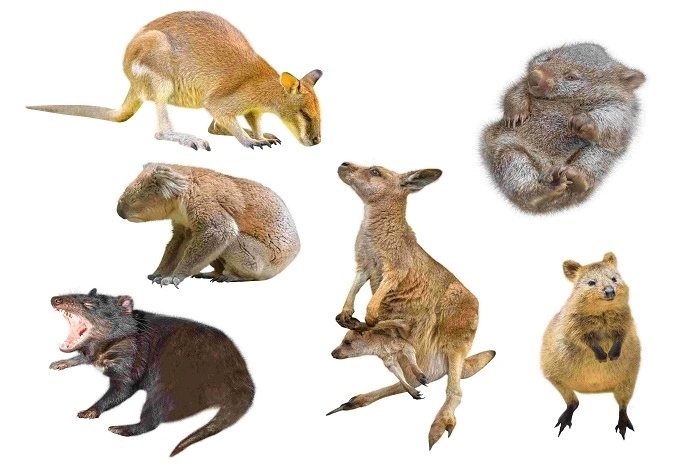Quokka
Happiest Animal in the World
Fennec Fox
Desert Animal Live Without Water
Sugar Glide
Able to Glide up to 45 Meters
Koala
Unique Animal to have Fingerprints
Panda
National Treasure Animal in China
Nothing is more inspiring than looking at photographs of adorable animals. Seeking adorable creatures is an excellent way to brighten your day if you're seeking a midday hobby or attempting to reduce tension. However, depending on where you reside in the world, some of the cutest animals on earth may be completely unknown to you.
Some of these lovely critters are rare; some may even be found at your local zoo. Animals play a crucial part in our ecosystems by dispersing seeds and promoting plant development, managing insects and pest populations, and limiting disease transmission.
Unfortunately, many species that offer us so much joy simply by existing are endangered owing to habitat loss caused by climate alteration and human land use. It is critical that we understand how to protect these species so that they can thrive and avoid extinction.
Top 5 Cutest Animals on the Earth
Top 5 Cutest animals of all time on the world are:
Quokka
Happiest Animal in the World

- Country of Origin:Australia
- Average Life Span:10 years
Quokka is recognized as one of the happiest animals in the world because of its unique smile-like facial expression. These dark species, which live mainly on small islands off the coast of Western Australia, are members of the kangaroo and wallaby families.
They are noted for their curiosity and friendliness, frequently approaching humans without fear. Their attractive nature has made them a favorite subject for wildlife photography.
Rottnest Island authorities preserve the quokkas by preventing anybody from touchingor feeding them. Human food can make them sick, and providing snacks and drinks can make quokkas overly dependent on humans.
Feeding and Diet:Quokkas are herbivores, which means they eat plants. They can be regarded as browsing herbivores that like various grasses and leaves, with Thomasia plants being their favorite.
The seasonal change in food supply availability is related to the fresh growth caused by fires. Quokkas are strongly connected to new, young growth. On Rottnest Island, their diet consists primarily of succulents, with wattle leavesas a secondary component.
Why are quokkas always smiling?They are regarded as the happiest animals in the world. Although they may not be smiling, their smile is just because of the shape of their mouth, which they open and push out to remain calm.
Can Quokka take as a pet?Regretfully, due to the Rottnest Island Authority Act of 1987, quokkas are protected creatures in Australia and cannot be kept as pets. Additionally, it is illegal to import quokkas as pets from Australia, so you will probably only encounter them on their home island.
Fox Fennec
Fennec Fox
Desert Animal Live Without Water

- Country of Origin:Sahara Desert
- Average Life Span:14 years
The fennec fox is the world's smallest fox. It is distinguished by its abnormally huge ears, which allow it to listen for prey below and aid in thermoregulation. The fox spends the day burrowed in the sand to avoid the intense heat and comes from its den at dusk to look for food.
They have the most enormous ears per body size of any canid. They use this to disperse heat and locate prey beneath the sand. They are also palefoxes, making them ideal camouflage.
Heavily furred paws give traction while sprinting in the sand and guard against the terrain's severe heat. Fennec foxes can also go for long periods without drinking water; they stay hydrated by food.
Feeding and Diet:Fennec foxes feed on insects, notably grasshoppers and locusts, birds, small rodents, lizards,and their eggs in the wild. They will also eat roots, fruits, and leaves to help them stay hydrated. Fennec foxes hunt alone at night, using their ears to listen for animals beneath the sand.
It has been reported that fennec foxes have killed and captured larger animals, including mature rabbits. The Smithsonian National Zoo's fennec foxes consume meat, variousfruits and vegetables, insects, and mice.
Can Fennec Fox take as a pet?Fennec foxes may be cute, but they are not ideal pets. Indeed, it is illegal in somecountries. They are protective, tough to housetrain, and potentially destructive. Specificnutrition, interaction and health care with other fennec foxes arerequired to maintain a high quality of life.
Sugar Glide
Able to Glide up to 45 Meters

- Country of Origin:Australia and New Guinea.
- Average Life Span:10 to 15 years
Sugar gliders are tiny mammals. They have big eyes and a lengthy, prehensile tail. As the name implies, sugar gliders have a pair of parachute-like membranes called patagia that extend from their forelegs to their hind legs. This allows them to glide from one tree to another in search of food while avoiding predators.
Their bushy tails act as rudders as they soar through the air, and their "wings" are made of a thin skin stretched between the fifth forefinger and the back leg. Their heads are striped in black, and their underbelly are white, although their fur is primarily grey.
Feeding and Diet:Sugar gliders' diets are variable and can change depending on the season and location. They consume pollen, nectar, and the sap of eucalyptus and acacia trees. They have also been seen methodically looking for spiders and beetles within tree cones.
Although sugar gliders face threats from wild predators, bushfires, and land clearance for agriculture, their numbers in the wild are thought to be stable.
Can Sugar Glider take as a pet?Sugar gliders may make fantastic pets and form close bonds with their human families if they are provided with the necessary care, enrichment, and socialization over time. They are available for purchase from shelters, pet retailers, and breeders around the United States.
Koala
Unique Animal to have Fingerprints

- Country of origin:Australia
- Average Life Span:10 to 15 Years
Koalas are frequently compared to plush toys because of their fluffy ears and prominent snout. Despite being referred to as koala bears, they are not related to bears. They are arboreal marsupials that eat mostly on eucalyptus.
Though eucalyptus is toxic to most animals, koalas have afibre-digesting organ called a caecum that helps neutralize the toxins in the leaves. Koalas are said to sleep 18 hours every day.
Like other marsupials, koalas have a strange start to life. It is not fully formed when it is born and is just the size of a giant jelly bean. A baby joey is indeed blind and deaf, yet it can still climb.
Feeding and Diet:Koalas are naturally independent. They are most active at night, mostof their time resting and feeding. Koalas only consume eucalyptus leaves. Eating leaves from a single plant may appear uninteresting.
Yet there are over 600 types of eucalypt trees, and each looks and tastes completely different to a koala. Koalas enjoy leaves from over three dozen different varieties.
Can a Koala take as a pet?No, it is not allowed anywhere in the world. Keeping a Koala as a pet anywhere, including in Australia, is unlawful. Aside from adequately licensed zoos, scientists and those caring for sick or injured Koalas or orphaned joeys are the only persons entitled to own a Koala. These people must have a particular permit from the wildlife authorities to undertake this work.
Panda
National Treasure Animal in China

- Country of origin:Central China
- Average Life Span:20 Years
The enormous Panda's distinctive black and white fur makes it easy to identify. Scientists believe that these patterns assist the Panda in concealing itself in snowy and sunny situations. Pandas need to eat a lot of food to receive all their nutrients.
Because of their vulnerability, these bears serve as a symbol of worldwide conservation efforts. The giant Panda is the world's most potent symbol of species conservation.
The beautiful black-and-white animal, which is beloved all over the world, is considered a national treasure in China and has represented the WWF since its founding in 1961. Its numbers are gradually increasing.
Feeding and Diet:Primarily found in temperate woods in southwest China's mountains, pandas primarily feed on bamboo. Depending on what portion of the bamboo they are consuming, they must consume anything from 26 to 84 pounds each day. They make use of the larger wrist bones that serve as their thumbs on either hand.
Can a Panda take as a pet?It is not allowed to take Panda as a pet. A private person cannotgive them the food or lodging they require. As pets, they will be unhappy and shorter. Additionally, it is forbidden to purchase pandas. In the nationswherepandas are native, they are legally protected.
The Panda is commonly considered peaceful, yet it has been known to attack humans on rare occasions. Pandas have been observed to coat themselves in horse faeces to shield themselves from chilly temperatures.
Role of Animals in the Growth and Regeneration of Plants
- Animals contribute significantly to the growth and regeneration of plants in the following ways:
- The forest floor is often covered with dead and decaying wildlife carcasses.
- Decomposers decompose them into simple organic compounds that plants absorb in the form of a dark-colored humus.
- Decomposers perform a crucial function in ensuring that nutrients are available to forest plants as they grow.
- Different forces, such as birds, animals, wind, and water, disseminate the seeds of various plants on forest soil.
- The spread seeds absorb nutrients from the soil and develop into seedlings, eventually expanding to produce forest vegetation.
What makes Animals Cute to love them?
Evolution has hardwired humans to find specific qualities 'cute', which makes us desire to love and protect creatures with such characteristics. Those traits are often shared with human babies, such as a small face on a roundish head. As a result, we consider animals' cute' because they have short snouts, small faces, and a roundish head. Adult animals such as pandas, quokkas, and koalas share these characteristics, which is why they are so popular in zoos.
Even creatures that are terrifying as adults, such as the Quokka, fennec fox, Koala, and Panda, begin life as adorable cubs. Some people are drawn to infant hippos and wish to cuddle with them. So that the same fierce or wild creatures we would never dream of picking as pets pull on our heartstrings quite as much when they are born.
Why can't Wild animals be taken as pets?
There are many reasons that Cute Wild animals cannot be taken as Pet include:
- Keeping a wild animal as a pet is appealing to some people. But we only need to consider the varied habitats in which wild animals exist - woods, deserts, wide-open areas, rivers, and oceansto realize that we cannot possibly meet their demands in captivity, particularly in a small cage or tank in a house or flat.
- For starters, we will never be able to provide them with the space they require in the wild to exercise and maintain their health and strength,the space in which their bodies are built to thrive.
- Keeping wild animals in cages or tanks, especially if they are somewhat large, prevents them from acting on most of their instincts, such as the need to run, fly, leap, dive, swing, or burrow into the ground.
- Furthermore, we frequently only have enough space to keep one animal and depriving social creatures of touch with others of their species is extremely cruel.
- Animals, like humans, become bored and dissatisfied when they lack activities, cannotact on their natural desires, and, in the case of friendly animals, are denied the companionship of others of their species.
- Many of them are cutest animals that are dangerous just because we cannot take them as pets.
- Animals cope with boredom and irritation by engaging in repetitive actions known as stereotypic behaviors. These acts serve no apparent purpose.






